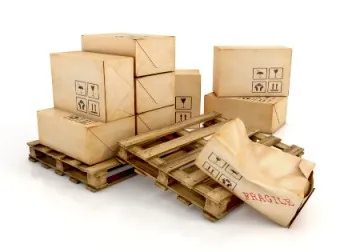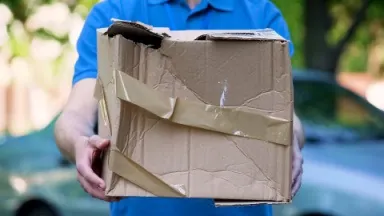Knowing how to file a freight claim is just as important as any other step in the shipping process. Hopefully, it doesn’t happen often, but sometimes freight gets damaged, and filing a claim will be necessary. There are so many pieces to the puzzle, and as an individual shipper or business shipper, you want your shipment to arrive at its destination without any issues. However, even when you package your cargo properly and do everything you can to protect it, sometimes freight damage or loss still happens. When this occurs, it’s important to know how to file a freight claim.

Important Freight Claim Definitions
While carriers do their best to handle, move and deliver your freight safely, sometimes mistakes happen, which result in shipment damage or loss. That’s why it’s important to learn what steps you may need to take should you have to file a freight claim. First, let’s go over a couple of important definitions:
– Consignor or shipper—The person selling and shipping the cargo.
– Consignee—The person receiving the cargo.
– Visible damage—Damage or loss is found and noted on the delivery receipt.
– Concealed damage—Damage or loss is found after delivery and is NOT noted on the Proof of Delivery (POD)
– Filing a freight claim—The process of documenting and proving carrier liability for shipping damage or loss and filing a claim with the carrier to get full or partial coverage for the cargo.
– Proof of Delivery (POD) or delivery receipt—The proof of delivery or delivery receipt paperwork is where any damages must be noted before the consignee signs for the shipment.
– Bill of Lading (BOL)—The BOL is standard paperwork that provides the customer, carrier, and driver with all the important information related to shipping costs and transport information. All parties in the shipping process should have a copy of the BOL.
– Limited liability coverage—This is coverage offered by the carrier for all shipments, but it may not fully cover the value of the shipment.
– Freight insurance—The shipper can purchase third-party freight insurance before the freight is shipped for additional coverage that is not provided by the carrier.
What Is Considered Damage?
Damage can either be visible damage found at the time of the delivery or concealed damage found after delivery is completed and the driver has left. In order to prove carrier liability for any damages or loss, it’s vitally important that the consignee or person receiving the shipment thoroughly checks the package and the cargo before signing for the shipment. The consignee must also make notes on the proof of delivery, or delivery receipt of all damages found, including damage to the packaging and to the cargo itself. If the consignee signs the paperwork without checking for or noting damages. The carrier can deny any claims filed later.
Tips for Finding Visible Damage
Checking for visible damage when you receive your shipment is important for both you and the person who shipped your package to you. It’s well worth the extra ten minutes it could take to review your shipment before you sign for it.
Here are some quick tips for finding visible damage before you sign for a shipment:
–Inspect your shipment—always. Is the shrink-wrap intact or damaged? Does the box or pallet appear crushed, torn, or have water damage? If it all looks good, that’s great. However, if you see damage, you must make a note on the Bill of Lading (BOL) and delivery receipt.
–Take photos of the damaged materials and cargo. Be specific in your descriptions of found damage and loss.
–If possible, open all containers while the driver is at your facility and write down everything you find on the delivery receipt.
–Contact your carrier immediately to report and discuss the found damages or loss.
–Keep the packaging, materials, and damaged products in a safe location. This is important because the carrier may want to inspect them once you file the claim. The consignee needs to keep damaged merchandise and shipping containers until the claim has been resolved.
–After you gather all the carrier-required claim materials and information, send it to the carrier’s claims department.
Tips for Finding Concealed Damage
Similar to finding visible damage, it’s also important to look for and make a note of any concealed damage or loss to your shipment. It’s best to open the packages while the driver is at your facility and before you sign any paperwork, but sometimes this may not be possible. In this case, concealed damage may not be noted on the delivery receipt.
Here are some tips for finding concealed damage:
–Open your package as soon as possible because you only have 5 days from the date of delivery to report concealed damage or loss to the carrier.
–Always take photos of damaged products and their packaging.
-Contact the carrier right away to report concealed damages you have found.
–Keep the package and all packaging materials.
–Keep the damaged items in a safe location. As with found damages, it is the responsibility of the consignee to keep damaged cargo and shipping containers until the claim is resolved.
–After gathering all the carrier-required claim materials and information, send it to the carrier’s claims department.
How to File a Freight Claim
Now that you know how to identify and document found and concealed damages, the next step is understanding how to file a freight claim. Each carrier has its own freight claim filing process, and it’s important to follow their instructions. Contacting your carrier for specific details will help keep the claims process moving. Often, carriers will ask for additional documentation, such as the manufacturer’s documentation/invoice, to prove the value of the freight.
Below are the general steps you need to take to file a freight claim:
– Provide all requested documentation, such as the Bill of Lading, proof of delivery, and manufacturer’s documentation/invoice.
– Complete the carrier’s claim form.
– Provide a copy of the repair quote if the item can be repaired.
– Provide a copy of the salvage/scrap value if the item is salvageable.
Filing a Freight Claim with the Help of a 3PL like FreightCenter
If you are working with a 3PL, they can help you file a freight claim. Here are the basic steps that FreightCenter recommends their shippers take when filing a freight claim:
Step 1: Accept the damaged shipment. Failure to accept the shipment will delay the claim process.
Step 2: Mark the Proof of Delivery document with a notation that the contents are “damaged” or “missing.” Be specific about any damages or loss to your shipment.
Step 3: Log in to your My FreightCenter account. Click on the “File Claim” link next to the shipment in question. Depending on your chosen carrier, you may need to contact our Claims Department by email to open a Damage Claim Ticket.
Step 4: Wait for the carrier to walk you through its specific claim process or wait for a Claims Department member to help you.
Remember, the damage claims process may take anywhere from 30 to a full 120 days. Pictures and manufacturer’s documentation or receipt showing value may help carriers expedite the process.
Limited Liability Coverage vs Additional Freight Insurance
All freight shipments are legally required to come with carrier-provided limited liability coverage. This limited liability coverage provided by the carrier is either a flat rate policy or an amount that adjusts based on the weight and the freight class. However, carrier-provided coverage doesn’t always reflect the actual value of the item being shipped. So, if your item is worth more than the standard coverage amount, it may be worth adding an independent freight insurance policy to cover your shipment.
Freight insurance provides additional coverage beyond the carrier’s default limited liability protection policy. These independent policies that are purchased through a third party can offer protection for the full value of your shipment and remove the need to prove liability if any damage or loss of shipment occurs. It’s important to consider all your coverage options because having additional coverage could greatly reduce the freight claims process.
Work with the Experts in Shipping
Partnering with a 3PL, like FreightCenter, can help you ship safely, securely, and with more peace of mind. That’s because FreightCenter works with top-quality carriers giving you the best freight rates and putting you in control of your freight shipments with access to our transportation management system.
Additionally, FreightCenter’s team of expert shipping agents can help you with everything from booking your shipment to filing a freight claim.
Start today by getting a free online quote, or call us at 800.7167.608.


